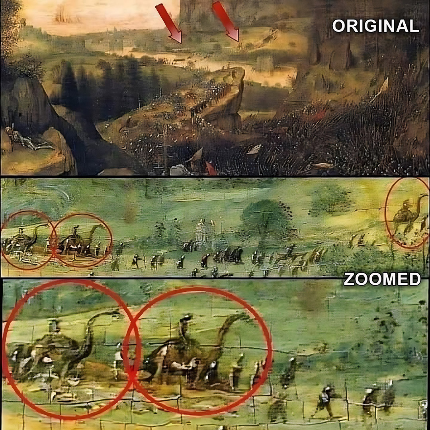In the intersection of art, history, and science, a painting by Pieter Bruegel the Elder, created in 1562, has captivated and puzzled scholars and enthusiasts alike. This artwork, showcasing Bruegel’s exceptional talent and meticulous attention to detail, has sparked a lively debate among art historians, scientists, and the public. The painting’s most intriguing feature is its depiction of creatures that bear a striking resemblance to dinosaurs, as recognized by modern science. This anomaly has led to various interpretations and speculations, suggesting there are hidden layers to Bruegel’s work.
Pieter Bruegel the Elder, renowned for his pastoral landscapes and scenes of peasant life, often embedded intricate narratives and keen observations of nature in his art. However, the presence of dinosaur-like figures in a 16th-century painting poses a historical conundrum, challenging our understanding of prehistoric life. It prompts the fascinating question: How did a Renaissance artist depict beings that were only scientifically identified centuries later? This puzzle has divided opinions, with some suggesting Bruegel may have had an extraordinary insight into the ancient past, while others propose more conventional explanations.

A close examination of the image collection featuring this artwork, which includes both the original and a magnified view of the debated figures, offers insights into this puzzle. To those unfamiliar with paleontology, these figures might indeed resemble dinosaurs, the prehistoric giants that have fascinated us since their fossils were first discovered. Their long necks and tails, along with their massive bodies, evoke images of the colossal creatures that roamed the Earth long before humans appeared.
However, an alternative hypothesis suggests that these are not depictions of dinosaurs but rather artistic representations of camels. Proponents of this view argue that Bruegel, known for his meticulous realism, may have depicted these exotic yet historically known animals. Given their distinctive body shapes and proportions, camels could easily be mistaken for more mythical creatures when viewed from a historical and cultural distance.
The discussion surrounding this artwork goes beyond mere aesthetic critique; it encompasses the broad narrative of knowledge dissemination, the evolution of scientific understanding, and the boundless creativity of the human spirit. The notion that a Renaissance artist might depict creatures from the distant past underscores our enduring fascination with the unknown and the limits of our knowledge. On the other hand, the idea that these figures might represent camels transports us back to Bruegel’s era—a time when the exotic was intertwined with everyday life, and the lines between reality and imagination were often blurred.
Attributed to Pieter Bruegel the Elder, this painting remains a captivating enigma, defying the constraints of time and scholarly disciplines. Whether it depicts dinosaurs, camels, or something else entirely, it encourages viewers to delve deeper, question their assumptions, and appreciate art’s enduring power to inspire exploration, dialogue, and wonder. By probing the multiple interpretations of historical art, we engage with the intricate process of interpretation and the subjective nature of human perception. Thus, Bruegel’s painting acts as a portal, reflecting our desire to connect with history, understand our present, and consider the vast possibilities of the future.
